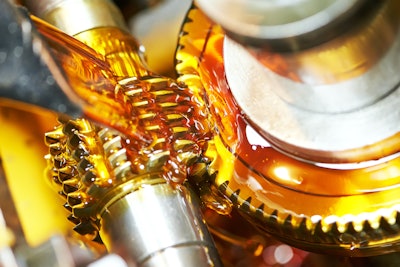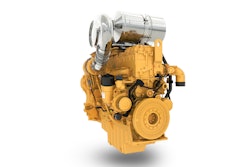
Sustainability is topic of much discussion in today’s off-highway industry. OEMs and equipment owners/operators are in continuous pursuit of new ways to decrease emissions, improve fuel economy and extend the useful lifespans of all forms of critical equipment.
Industrial fluids—be they hydraulic fluids, greases, metalworking fluids, industrial gear or other fluids—have an important role to play in this pursuit of sustainability. High-performance options can help equipment operate to its full potential, optimizing fuel consumption and overall machine efficiency, while protecting critical parts to extend lifetimes.
But for these fluids, there are other characteristics to consider. For example, biodegradability and environmental friendliness. Because considerable amounts of industrial fluids make their way into the environment every year, a fluid’s ability to safely decompose has become a highly sought-after trait. The U.S. Environmental Protection Agency (EPA) defines such fluids as environmentally acceptable lubricants (EALs). While EALs have traditionally been seen as a niche product, demand is rising due to evolving regulatory requirements.
As all industries seek to enhance their eco-conscious reputation, it is important to understand some of the subtler differences between sustainability and environmental friendliness, and how EALs differentiate from bio-based fluids.
Sustainable or Environmentally Friendly?
The preferred framework for sustainability evaluates a product’s overall effect on the environment across its entire life cycle. This accounts not only for the product’s impact while it is in use, but also in the steps leading up to its creation and those of its eventual end of life. Calculating these figures, taking into account the entire history of how the product is made, involves a methodology commonly known as life cycle analysis.
It is against this backdrop that we can better evaluate different lubricant and fluid formulations and classifications that have emerged in recent years. EALs offer a good example. As noted earlier, EALs are explicitly defined by the U.S. EPA as formulations that have demonstrated acceptable levels of biodegradability, minimal aquatic toxicity and non-bioaccumulative potential.And it is worth digging into the specifics of these terms:
- Biodegradability: The capacity of lubricants to be decomposed by microorganisms over time into:
- A combination of simpler by-products (primary biodegradation)
- Carbon dioxide and water (ultimate biodegradation)
- Minimal Aquatic Toxicity: Low toxicity to aquatic organisms according to tests defined by the Organization for Economic Cooperation and Development (OECD) and EPA test guidelines.
- Bioaccumulative potential: the buildup of chemicals within the tissues of an organism over time.
These characteristics are particularly important within the realm of off-highway equipment. Because whether via machine seepage, accidental spillages or careless disposal, the final part of any industrial fluid’s life cycle may very well occur within the natural environment. Their ability to minimize harm to delicate ecosystems is critical. Traditional industrial fluid formulations do not typically account for these consequences.
Growing environmental awareness has also seen increased adoption of bio-based lubricants and fluids in off-highway applications. Frequently, bio-lubricants are made from natural oils and avoid the use of petroleum-based oils in their formulations—making them generally viewed as a more sustainable option. However, bio-lubricants need only be made from natural oils to be labeled as such, and unlike EALs, do not need to meet stringent criteria that certifies their eco-friendliness. A bio-lubricant may be biodegradable, but isn’t necessarily so by definition. For example, a bio-lubricant may still incorporate an additive component that is not bio-degradable. These are important distinctions to make as the off-highway market continues to seek to maximize its environmental protection.
Coming back to what makes a lubricant sustainable, the source of raw materials and EAL-qualifying characteristics of a lubricant only represent portions of a lubricant’s lifecycle. One needs a complete lifecycle analysis to honestly say that one particular formulation is more sustainable than another. That doesn’t minimize the positive impact of using EAL qualified lubricants, of course. Included in that lifecycle analysis is the in-use performance of the lubricant.
Making an Impact in Off-Highway Equipment
As mentioned at the beginning of this article, advanced fluids have the potential to optimize today’s most efficient off-highway equipment. By delivering high levels of performance across a broad range of performance characteristics, the right fluid can help machines achieve optimal fuel consumption, maximum efficiency, and extensive service life. It follows, then, that EALs—in order to best benefit the end user, and the planet—should be able to do just the same.
There are a range of performance characteristics that any reliable industrial fluid—EALs, bio-lubricants or otherwise—should be able to provide. They include:
- Wear protection. Preventing the premature wear of metal surfaces as they come into contact with each other is the core function of an industrial lubricant.
- Extreme-pressure protection. Industrial fluids used in demanding applications require extreme-pressure additives to withstand severe operating conditions.
- Emulsibility. Depending on the application, many industrial fluids must be able to properly emulsify with water. Other fluids may need to resist emulsification. The right chemistry is required in either case.
- Antifoam performance. When air becomes entrained within an industrial fluid, foam can result, which may compromise its ability to form a protective film. A high-performance fluid will be resistant to such foaming.
- Corrosion and rust prevention. A variety of off-highway fluids come into regular contact with water and air at elevated temperatures—conditions that can lead to damaging rust and corrosion.
- Viscosity and friction performance. Some applications require specifically calibrated thickness and friction to enable proper machine performance.
Many traditional chemistries deployed in most off-highway fluid formulations are not applicable in EAL products. This is because many of those ingredients, which help a completed fluid deliver each of these performance characteristics, do not meet EAL standards for biodegradability, nontoxicity, and bioaccumulation. For example, some of the most common and reliable anti-wear chemistries used today are zinc based. A nonmetallic option is required to meet biodegradability standards.
Applicable chemistries do exist, making high-performance EAL formulations are possible—and they will only become increasingly important as industries everywhere seek to minimize their environmental impact. For the off-highway equipment industry, it is worth investigating the application of these kinds of formulations today. They are only expected to gain market share as regulatory pressure grows, and as the world grows increasingly eco-conscious.
Ensuring that EALs maintain the right performance characteristics—to enable off-highway machinery to achieve peak efficiency and reliability—is essential. Such formulations represent an important tool for the off-highway equipment industry to maximize environmental protection, and it can be worth opening the conversation about such options with your fluids supplier.

















